Bai Dinh Pagoda (Chùa Bái Đính) is a Buddhist temple complex located in Gia Vien district, about 100 km from Hanoi city center. The temple is part of the Trang An Landscape Complex, a UNESCO World Heritage Site that includes natural and cultural attractions. Bai Dinh Pagoda is the largest pagoda in Vietnam and Southeast Asia, covering an area of 539 hectares. The pagoda consists of an ancient pagoda and a new pagoda that were built in 2003 and completed in 2010.
The pagoda is famous for its many records, such as the largest bronze Buddha statue, the largest bronze bell, the largest number of Arhat statues, and the longest corridor with Arhat statues in Asia. Bai Dinh Pagoda is a popular destination for pilgrims and tourists who want to admire the architecture and art of the temple, as well as enjoy the panoramic view of the surrounding mountains and valleys. In this blog post, we will show you how to rent a car to Bai Dinh and explore the best things to do and see in Bai Dinh Pagoda.
Why Rent a Car to Bai Dinh?
Renting a car to Bai Dinh is one of the best ways to travel from Hanoi to Bai Dinh and enjoy your visit at your own pace and convenience. By renting a car, you can:
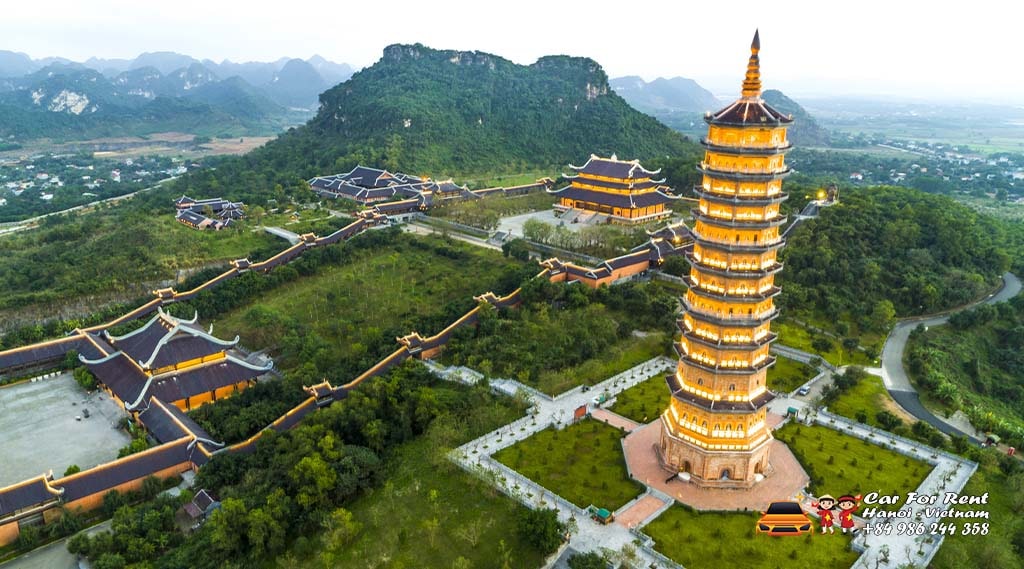
- Save time: You can avoid the hassle of finding and waiting for public transportation, which may be crowded, slow, or unreliable. You can also choose the shortest and fastest route to your destination, without having to stop at multiple places along the way.
- Save money: You can compare different prices and options online and choose the one that suits your needs and budget. You can also save on fuel costs by choosing a fuel-efficient car type.
- Have flexibility: You can choose your own itinerary and schedule, without having to follow a fixed or limited tour program. You can also visit places that are not easily accessible by public transportation, such as the Trang An Scenic Landscape Complex or the Hoa Lu Ancient Capital.
- Have comfort: You can enjoy a comfortable and private mode of transportation, particularly during Hanoi’s hot and humid seasons. You can also avoid the hassle of carrying your luggage or dealing with crowded and noisy vehicles.
- Have safety: You can drive safely with a reliable and well-maintained car that meets the international standards and regulations. You can also avoid the risk of getting scammed or overcharged by dishonest drivers or operators.
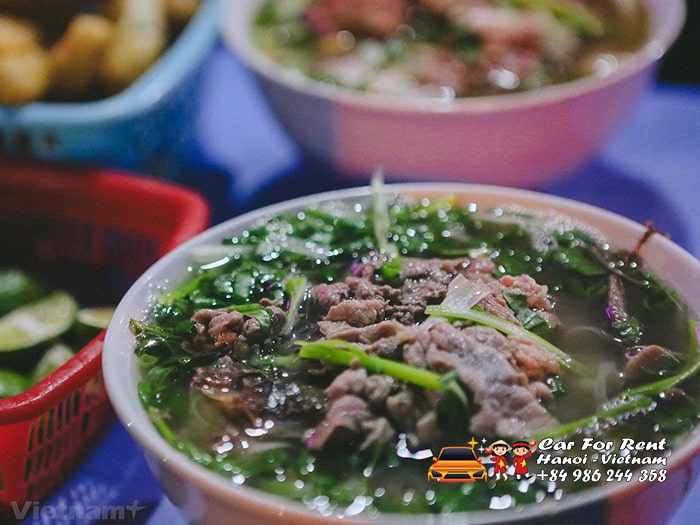
How to Find the Best Deals and Services for Car Rental to Bai Dinh?
There are many factors that you need to consider when looking for the best deals and services for car rental to Bai Dinh, such as:
- Car type: You need to choose a car type that matches your group size, luggage needs, and preferences. There are different car types available for rent in Hanoi, such as economy, standard, SUV, people carrier, estate, convertible, or luxury. You can check out some examples and compare prices on platforms like Rentalcars.com1.
- Car rental company: You need to choose a reputable and trustworthy car rental company that offers high-quality cars and services. There are many car rental companies operating in Hanoi, such as Avis2, Rental Cars Hanoi3, or Hanoi Journey. You can read reviews and ratings from previous customers to get an idea of their performance and reputation.
- Pick-up and drop-off location: You need to choose a convenient and accessible pick-up and drop-off location for your car rental. The most common pick-up location is Noi Bai International Airport (HAN), which is about 45 km away from Bai Dinh Pagoda. However, you can also choose other locations in the city, such as your hotel or a designated point.
- Booking method: You need to choose a convenient and secure booking method for your car rental. The most common booking method is online, where you can easily compare different options and prices, make reservations, and pay with cash or credit card. You can use platforms like Grab1, Welcome Pickups2, or Klook3 to book your car rental online or through their apps.
- Additional services: You need to check if there are any additional services or fees that are included or excluded in your car rental deal. Some of the common additional services or fees are insurance, fuel, driver, tolls, taxes, surcharges, or extras. You need to read the terms and conditions carefully before confirming your booking.
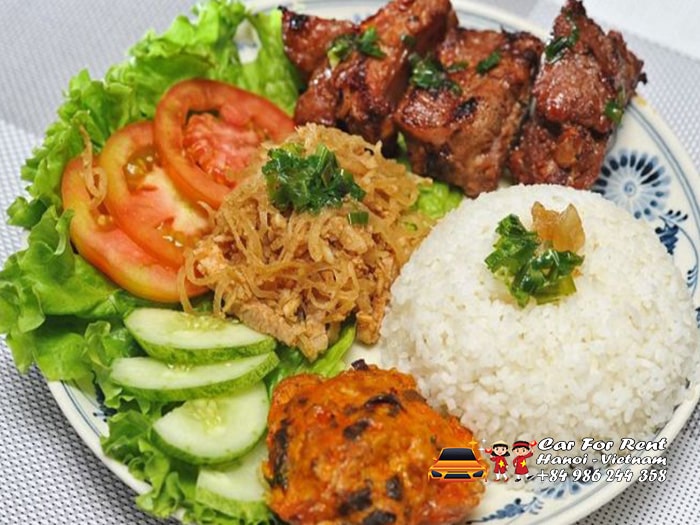
What to Do and See in Bai Dinh Pagoda?
Bai Dinh Pagoda offers a variety of attractions and activities for visitors of all ages and interests. Some of the highlights include:
- Ancient pagoda: This is the original pagoda that was built in the 11th century by Zen master Nguyen Minh Khong. The pagoda is located on top of a hill surrounded by ancient trees and rocks. The pagoda has a simple but elegant architecture with wooden pillars and tiled roofs. The pagoda also houses many precious relics, such as statues of Buddha Shakyamuni, Amitabha Buddha, Maitreya Buddha, Manjushri Bodhisattva, Samantabhadra Bodhisattva, Avalokiteshvara Bodhisattva, Ksitigarbha Bodhisattva, and Vajrapani Bodhisattva.
- New pagoda: This is the new pagoda that was built in 2003 and completed in 2010. The pagoda is located at the foot of Dinh mountain (also known as Ba Rau mountain), covering an area of 80 hectares. The pagoda has a majestic and impressive architecture with stone pillars and tiled roofs. The pagoda also features many records, such as:
- The largest bronze Buddha statue in Vietnam (100 tons) located in Phap Chu hall (also known as Tam The hall).
- The largest bronze bell in Vietnam (36 tons) located in Bell tower (also known as Thap Chung).
- The largest number of Arhat statues in Vietnam (500 statues) located along Arhat corridor (also known as Hanh Cung).
- The longest corridor with Arhat statues in Asia (3 km) located along Arhat corridor (also known as Hanh Cung).
- Electric car ride: This is an optional service that allows you to travel from the entrance gate to the new pagoda by electric car. The electric car ride takes about 15 minutes and costs 30,000 VND per person per way. The electric car ride is a convenient and eco-friendly way to enjoy the scenery of Bai Dinh Pagoda.
- Cable car ride: This is another optional service that allows you to travel from the new pagoda to Phat Tich tower (also known as Thap Phat Tich) by cable car. The cable car ride takes about 10 minutes and costs 80,000 VND per person per way. The cable car ride is an exciting and adventurous way to enjoy the panoramic view of Bai Dinh Pagoda.
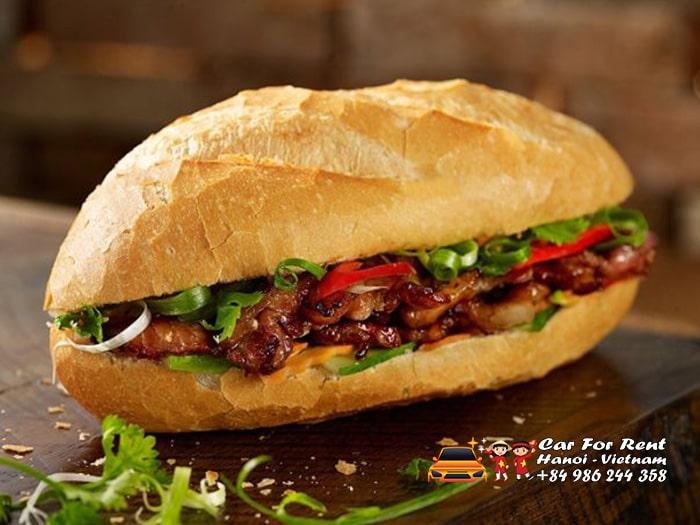
Conclusion: Enjoy Your Visit to Bai Dinh Pagoda with Car Rental
As you can see, renting a car to Bai Dinh Pagoda is one of the best ways to visit this majestic and impressive temple from Hanoi. By renting a car, you can save time, money, have flexibility, comfort, and safety while exploring the architecture and art of Bai Dinh Pagoda.
We hope this blog post has helped you learn more about car rental to Bai Dinh Pagoda and how to visit this attraction with ease. If you have any questions or comments, feel free to leave them below. We would love to hear from you!
Contact us:
Car For Rent Hanoi VietNam
https://zalo.me/0986244358
Since ancient times, the pagoda has been one of the centers of Buddhism (worshiping Buddha), Taoism (worshiping Cao Son god), and mother worshiping (Lieu Hanh model). To this day, the restored temples and palaces include 21 main categories, with two temples: the old Bai Dinh pagoda and the new Bai Dinh pagoda.
Who is the abbot of Bai Dinh pagoda?
The abbot of the pagoda is the Most Venerable Thich Thanh Nhieu – Standing Vice Chairman of the Executive Council of the Vietnam Buddhist Sangha, the Most Venerable Thich Thanh Nhieu is also the Abbot of Tam Chuc Pagoda (Ha Nam).
Likes the Noise
Most Venerable Thich Thanh Nhieu
The deputy abbot is Venerable Thich Minh Quang – Deputy Chief of the Central Office of the Vietnam Buddhist Sangha in Hanoi, Venerable Thich Minh Quang is also the Vice Abbot of Tam Chuc Pagoda (Ha Nam).
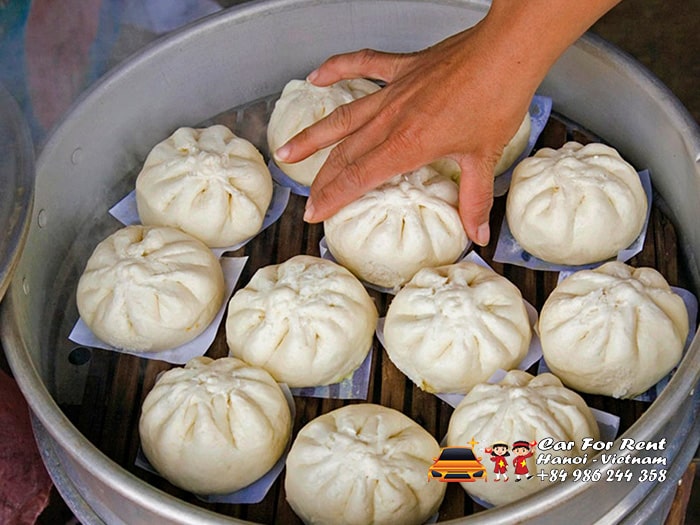
Most Venerable Thich Minh Quang
Where is Bai Dinh Pagoda?
Bai Dinh Ninh Binh pagoda cultural and spiritual tourist area belongs to Trang An Scenic Landscape Complex, located in Gia Sinh commune, Gia Vien district, Ninh Binh province, 7km from Hoa Lu ancient capital and 15km from Ninh Binh city. kilometer.
Bai Dinh mountain is the starting point of Hoa Lu limestone mountain system in the northwest and also the foothills of the Himalayas, where Buddhism originated. The mountains in the mountain system have an average height of 70-170m.
With an altitude of 187m, Bai Dinh mountain is the highest mountain in the region, also known as the master mountain / king mountain of Hoa Lu limestone mountain system. Bai Dinh mountain, according to the folk interpretation, means: the mountain with worship on the top.
Area of Bai Dinh pagoda
Bai Dinh pagoda spiritual tourist area has a total area of 539 hectares (especially the old Bai Dinh pagoda is 27 hectares wide, the new Bai Dinh pagoda is 80 hectares).
Address of Bai Dinh pagoda
Address: located in Gia Sinh commune, Gia Vien district, Ninh Binh province.
Map of Bai Dinh pagoda
To go sightseeing, or travel to Bai Dinh pagoda, you can use Google Maps to find a road map. This is a very famous spiritual tourist area, so the roads are very convenient and the information is clear. The locals do not know anyone, so you have many ways to find your way to the temple.
Map to visit Bai Dinh pagoda
The most detailed map to visit Bai Dinh pagoda
Tram fares and sightseeing in Bai Dinh Pagoda
Service Price
Tram ticket 60,000 VND/person
Tickets to visit the stupa 50,000 VND/person
Ticket price for tour guide 300,000 VND/tour
Tram ticket: 60,000 VND/person
Tickets to visit the Stupa: 50,000 VND/person
Tour guide ticket price: 300,000 VND/tour
Is Bai Dinh Pagoda open?
Is Bai Dinh Pagoda open yet? Is Bai Dinh Pagoda open for Tet?
Updated to November 15, 2021, Bai Dinh Pagoda has reopened to welcome tourists from all over the world and Buddhists to come to worship and sightseeing. Visitors to Bai Dinh Pagoda must strictly follow the Covid-19 prevention measures of the Ministry of Health and Chinh Phu.
During and after the Lunar New Year 2021, whether the temple will be open is a question of many tourists from all over the world. Currently, Bai Dinh Pagoda is still open for tourists to visit. However, visitors must take measures to prevent the Covid-19 epidemic such as: Taking body temperature, disinfecting hands, wearing masks and making medical declarations.
Bai Dinh Pagoda is temporarily closed from May 7, 2021 to prevent the Covid-19 epidemic. The reopening announcement will be updated in this article.
Bai Dinh Pagoda Festival
On the 6th of January every year (the 6th day of the Lunar New Year), Bai Dinh Pagoda holds an opening ceremony, also known as the Bai Dinh Pagoda Festival. However, because of the Covid epidemic, the Festival 2020, 2021 will not be held.
Experience going to Bai Dinh pagoda
What is the best time to visit Bai Dinh Trang An Pagoda?
If you want to enjoy the festive atmosphere, the bustle of the spring travel, you can choose to go to the temple from January to March of the lunar calendar.
This is also the time when the spring weather is warm – a beautiful time for pilgrimages and New Year’s ceremonies at Bai Dinh Trang An. You can combine spring travel and sightseeing, pagoda ceremony to pray for peace and participate in festivals in Trang An and Bai Dinh.
If Trang An festival starts from March 17 to March 21 of the lunar calendar, Bai Dinh pagoda festival takes place on the first day of the new year on January 6 of the lunar calendar.
With the experience of going to Bai Dinh pagoda, I advise you to note that this is also the peak tourist season, so visitors come here are very crowded, sometimes causing overcrowding and crowding.
Therefore, if you want to enjoy the purity, you can visit the pagoda and travel to Trang An at other times of the year. Looking at it, in each season, Bai Dinh – Trang An pagoda has its own beauty, but the most interesting thing is the atmosphere of romantic and poetic scenery in autumn.
Pictures of Bai Dinh pagoda
Image of Bai Dinh pagoda – Arhat corridor (Thu Phuong)
What to prepare and what to note when going to Bai Dinh pagoda?
When visiting and sightseeing the temple, visitors should pay attention to wear discreet and polite clothes, do not burn incense too much and dispose of garbage in the right place. At the beginning of the year, many people come to pilgrimage, tourists should take the initiative to preserve personal property, avoid losing belongings.
In order to prevent the Covid 19 epidemic, visitors to Bai Dinh pagoda need to make medical declarations, wear masks, disinfect hands… strictly follow the Government’s regulations on epidemic prevention and 5K recommendations of the Ministry of Health. .
About the costumes: The space, the temple area is very large, visitors will have to walk and climb the mountain, so it is recommended to use comfortable, rubber, flat soles, sports shoes instead of high heels to dress up. Protect your feet as well as convenient for moving.
Costumes when entering the place of worship should be discreet and dignified. If you wear the clothes for taking photos, you need to wrap up with cloth, Buddhist shirt, etc. before entering the ceremony.
Early spring often has light drizzle, so you should bring a backup umbrella. In the summer, you need to bring sun protection accessories: shirt, hat, hat, sunglasses, water …. In winter dress warmly.
Remember to bring change when you go to mass if you want to make merit or donate to the temple. Avoid putting money on Buddha statues that spoil the beauty of the temple area, instead put them in merit boxes.
About the offerings: Temple rituals are important in sincerity and actual good deeds in daily life, so temple offerings should be prepared delicately, neatly, not too ostentatiously, and especially Note that the offerings are vegan, such as fruits, cakes, water, incense, candles, etc.
Bai Dinh hotels and motels
Bai Dinh Guest House
Staying at Bai Dinh hotel
Bai Dinh Guest House is located in the temple grounds, built with ancient and luxurious architecture, bearing bold classic Asian features.
Located amidst the majestic quiet space of mountain nature, Bai Dinh Hotel is an ideal place for tourists from all over the world to relax, meet and visit Bai Dinh Pagoda.
Bai Dinh Guest House is designed with materials of deep tones with the look of a stately and peaceful place with furniture made from rare woods, stepping into this place is like being lost in a mellow and relaxed world. absolute.
Resting here, you will feel that the fatigue and frustration of modern life are suddenly dispelled, immersed in the fresh beauty of nature, occasionally listening to the sound of temple bells.
If you do not like to travel far from other tourist destinations of Ninh Binh province, you can consider choosing to stay in a number of homestays right near Trang An or Ninh Binh city center.
The fastest way is to book a room on Agoda, there are many options for you to choose from such as: hotel, homestay, resort, Bai Dinh hotel… Discount codes when booking are also available for you to choose to book on. : Agoda
Explanation about Bai Dinh pagoda
Ancient Bai Dinh Pagoda
Well of Jade
Ngoc well has an area around 6000m2, diameter 30m, depth 10m, water level 6-7m, surrounded by 4 octagonal floors and well water is jade green, natural water source has not dried up since ancient times. hours despite being located on high terrain.
The Triple Gate of Bai Dinh Pagoda
In the journey to Bai Dinh pagoda in Ninh Binh, you will pass through the Tam Quan gate, with four Chinese characters “Minh top beauty”. Legend has it that these are four words dedicated by King Le Thanh Tong (1460-1496) and a poem of four great words in Chinese.
This is a very beautiful and valuable Buddhist temple, worthy of being inscribed in the inscription engraved on the top of the bronze for everyone to know.
Translation of poems about Bai Dinh pagoda:
Dinh Son’s reputation is really high
Protecting the ancient citadel
The poem given by the king in Chinese is as follows:
Minh of fame
Dinh Son monopolizes the highest reputation
Self-accumulating Imperial Capital/Tide
Japan’s masterpieces of common spirit
The beautiful Huyen Son is coated with European metal
Human genius, earth spirit should be prosperous
The sacred mountain is beautiful and stable.
The two sides of the three sides have a couple of sentences:
Giang Son Trung Tu is a beautiful scene of fairyland, and the atmosphere is high
Van Vu Thi graces the Southern Kingdom, the lord of the kingdom, and the royal family
Translate:
Mountains and rivers create good air, the scenery of fairyland is unmatched
Rain clouds give great grace, the sacred land of the South country is all over
Through the three-way gate, turn right, visitors will come to the altar of the Patriarch Dat Ma. This is the Trinh Gate to report the names and residences of visitors to the temple. Master Dat Ma is considered to be the founder of Zen Buddhism and Chinese Shaolin Martial Arts.
Ancient temple of worship
Buddha’s Cave
Buddha’s Cave
The cave/cave for worshiping Buddha, also known as Sang cave, is about 25m long and 15m wide. This is the Buddhist temple founded by Lord Nguyen Minh Khong around 1096-1106. In front of the cave are 2 Dharma Protectors: Mr. Khuyen Thien and Mr. Cheng Evil, inside is the main shrine of the Tam Bao, or three phoenixes. represent three times: Past, Present and Future.
On the right hand side is the consecration of the Holy Spirit and on the left hand side is the consecration of the Lord God.
Currently, the worshiping statues here are all cast in solid bronze and plated with gold. It can be said that the space here is both sacred and pure, where Buddhists and sentient beings most clearly feel the holiness and liberation of the Buddha realm.
Temple of Cao Son god
Going deep into the Sang cave, behind the Buddha altar, is the altar of Cao Son god. According to the divine genealogy, Cao Son Dai Vuong was Lac general Vu Lam, the 17th son of King Lac Long Quan, the god taught and helped people make a living, so the people built a temple.
God Cao Son along with god Thien Ton and god Quy Minh are the three gods who reside at the three gateways to the west, east and south of Hoa Lu Ancient Capital. Thanh Nguyen temple, also built with its back to the mountain, has a corridor separating it from the valley in front.
The medicinal garden in front of the temple of Saint Cao Son
Legend has it that this is a medicinal garden for people of Zen master Nguyen Minh Khong, named Sinh Duoc, which means living medicinal garden, natural medicine garden, in contrast to prepared and impregnated drugs.
Later, many physicians came here to find medicinal plants to cure diseases and save lives.
The medicinal garden has an area of about 4 hectares, with precious medicinal plants such as: birth earth, Hoai Son, ginseng, five skins, single bones, and ginseng.
Pictures of Bai Dinh pagoda
Stupa of the temple
This is a temple located in the middle of the “hand throne” arc of Bai Dinh mountain, one side is a cave worshiping Buddha and Cao Son god, the other side is a cave worshiping Mother.
National monk Nguyen Minh Khong, self name Nguyen Chi Thanh, was born in 1066 in Diem Duong village (now Gia Thang commune, Gia Vien district).
He ordained at the age of 11 and made a brotherhood with Tu Dao Hanh and Nguyen Giac Hai. He is considered the god of medicine when he cures King Ly Than Tong’s “tiger” disease with herbal medicine. It can be said that he was one of the first people to find a cure with Southern medicine. He died in 1141, aged 76.
He is also known as the ancestor of bronze casting, who is credited with creating the famous “four great spirits” of the Ly Dynasty, which are Bao Thien tower, Quy Dien bell, Quynh Lam statue and Pho Minh cauldron.
Currently, he has many places in the country to set up temples. His name is closely associated with the Sinh Duoc garden at Bai Dinh mountain, the legends and legends about Saint Nguyen are still dense in the mountains of Bai Dinh pagoda and the surrounding areas.
Mother’s Worship Cave
This cave is also known as Dark cave / cave, worshiping the Holy Mother. There are 7 interconnected small caves. In the middle of the cave, there are stalactites hanging down like a pillar, called “the most sacred pillar” (a pillar against the sky).
Mother worship is indigenous to Vietnamese people. Dark Cave worships the goddess Lieu Hanh, who is both a saint and a human being, she is the mother of the world, known by everyone for “three births, three transformations”.
Discount codes for airline tickets, hotel rooms
In the Dark cave, there is also a “way to heaven” and a “way to hell”.
Fairy Pond
Inside the grotto there is a small pond called Ao Tien. This can also be considered a “happy gathering”, because the pond is formed naturally, the water from small stalactites drops all year round, so it never runs out of water.
New Bai Dinh pagoda mountain area
In 2003, based on the foundation of the ancient temple, Xuan Truong Construction Enterprise restored and invested in building a new Bai Dinh pagoda. Currently, the pagoda has 8 main construction items: Tam Quan Gate, Arhat Corridor, Bell Tower, Bodhisattva Guan Yin Palace, Phap Chu Temple, Tam The Palace, Maitreya Buddha and Bao Thap. With a number of records that have been certified by the Vietnam Book of Records Center, they are:
The largest bronze bell in Vietnam (weighing 36 tons, 18.25m high).
The bronze statue of Buddha Shakyamuni is the tallest and heaviest in Vietnam (weighing 100 tons, 10m high).
The largest bronze statue of Tam The in Vietnam (each statue weighs 50 tons and is 7.2m high).
The pagoda has the largest Water Well in Vietnam (30m in diameter).
The largest bronze Buddha statue in Vietnam (weighing 80 tons, 5.4m high).
Corridor of 500 Arhats, the most in Vietnam.
The pagoda has the most Bodhi trees in Vietnam.
The heaviest set of bronze diamond statues in Vietnam (each statue weighs 4 tons, 3.95m high).
The bronze statue of Mr. Khuyen Thien and Chuoc Evil is the tallest and heaviest in Vietnam (20 tons each, 5.2m high).
The pagoda has the largest wooden altar in Vietnam.
The pagoda has the largest pair of bronze cranes in Vietnam.
The largest bronze Maitreya Buddha statue in Southeast Asia (weighing 80 tons, 10m high).
Asia’s tallest stupa (Asia’s tallest Buddhist stupa) is 99m high, with 13 floors.
In addition, the pagoda also has other works such as: Cultural Park and Buddhist Academy, Dam Thi lake area… still under construction.
Pictures of Bai Dinh pagoda
The three-way gate of Bai Dinh pagoda
Three gates are 3 gates, according to Buddhism, that is Khong Quan, Trung Quan, Jia Quan; Tam Quan also means 3 gates: the door of suffering, the door of impermanence, the door of no-self.
Tam Quan is built entirely of wood, to build Tam Quan, people used about 550 tons of logs. Tam Quan has a bed-stack architecture, 16.5m high, 13m wide, 32m long.
In front of the three gates, on the left and right sides, there are two stone lions, representing the power of wisdom. In the case of placing in front of the Tam Quan it also carries the idea of controlling the pilgrim’s soul.
In Tam Quan, on the right is a statue of the good deity, and on the left is a statue of the evil god.
Above the three gates, there is an image of the wheel of reincarnation, carved in the wind, symbolizing the ceaseless rhyme of Buddha Dharma, of heaven and earth.
In the middle is the swastika, symbolizing the fire of samadhi (sacred fire). The swastika also symbolizes the wisdom and compassion and generosity of the Buddha. The swastika expands to the two sides, representing the infinite movement of the Buddha’s power, extending to the four directions, extending endlessly.
The temple is attached to the la Han corridor
Along the left and right corridors, 500 Arhat statues, made of stone, are placed by artisans of Ninh Van stone village (Hoa Lu). Therefore, the corridor is also called the Arhat road.
Arhat Street consists of two rows, each row 117 compartments, 526m long.
Arhats are disciples of Shakyamuni Buddha, they have not yet become Buddhas, so they are called Arhats.
There are many jackfruit trees planted on both sides of this road. In Buddhism, jackfruit is Paramita. The Sino-Vietnamese sound is Paramita, which means “beyond the shore” (to the shore of enlightenment). The meaning of the jackfruit tree is great enlightenment, the peak is liberation. Therefore, the jackfruit tree is a sacred tree, associated with Buddhism (jackfruit wood is used for making pagodas, making Buddha statues; jackfruit leaves are used to make offerings to the Buddha, etc.).
Bai Dinh pagoda bell tower
The steeple has an octagonal architecture, has 3 curved roofs, 18.25m high, 17m in diameter, bearing the shape of a lotus. The steeple has one way up and one way down.
The bronze bell inside the steeple weighs 36 tons, cast by artisans in Hue. This bell has been certified by the Vietnam Book of Records Center as the largest bronze bell in Vietnam.
The temple has a bell tower
Bell tower in the temple
The Palace of Bodhisattva Avalokitesvara
This is a building made entirely of wood, about 900m3 of logs were used for this work. The shrine consists of 7 compartments, 14.8m high, 16.8m wide, 40.4m long.
The statue of Bodhisattva Avalokitesvara is 5.4m high, including the pedestal is 9.57m; weighs 80 tons, if including the pedestal is about 100 tons.
As we all know, Guanyin is the buddha representing the four great immeasurables: great compassion, great compassion, great joy, and great equanimity, so everywhere, Guanyin Buddha always symbolizes kindness. compassion, save suffering, save all sentient beings.
On both sides of the thousand-eyed, thousand-armed Guanyin statue, there is also a statue of Avalokitesvara representing compassion and rejoicing placed on the left hand and on the right hand is Dai The Tri Bodhisattva representing wisdom. Both statues are made of wood, each statue is 10m high and weighs 4 tons.
Bai Dinh Pagoda
Pictures of Tam The Palace
The French Palace is the owner of Bai Dinh Pagoda
In front of the main gate of Phap Chu Palace is a pond of liberation, an area of about 5000m2. There are many bodhi trees around the lake. These are the trees that the comrades led, the heads of state planted when visiting the pagoda.
It is possible to introduce more about the Bodhi tree (the Sino-Vietnamese pronunciation is Bu-da) which means the enlightened one. Bodhi tree is a sacred tree associated with Buddhism, bringing enlightenment factors, so it is placed outside.
Phap Chu Palace was built according to the architecture of 2 floors and 8 roofs, including 5 compartments, 30m high, 44.7m long, 43.3m wide, with a total area of 1945m2.
The statue of Phap master is 10m high, weighs 100 tons, crafted by artisans of Y Yen bronze casting village.
To the right of the hall, is a statue of Mr. Anam, 7.2m high, weighing 30 tons of bronze, one of the Buddha’s disciples with intelligent and bright qualities. He was someone who directly heard many of the Buddha’s teachings. On the left is a 7.2m high statue of Ca Lettuce weighing 30 tons of bronze. He was the leading monk of “begging for food”, so he was called “First Dau Da”.
On both sides of the shrine, there are Bat Bo Diamond statues: These people are responsible for protecting the Buddha Dharma in the outer circle.
The Diamond Bowl includes:
Clearing Diamond Wealth.
Accumulation of Diamond God.
Hoang Sui Diamond Bridge.
Bach Tinh Thuy Diamond.
Red Flame Diamond Chain.
Defining Diamond Ears.
Tu Hien Diamond.
Great Power Diamond.
Panoramic view of Bai Dinh pagoda from the stupa
Panoramic view of the pagoda from the stupa (NguyetMoon)
Temple of the Three Worlds, Bai Dinh Pagoda
Tam The Palace was built with a 3-storey roof architecture, including 7 compartments and 2 wings, with a total of 66 large and small columns made of concrete, wood paneled. The Buddha hall is 34m high, 59.10m long, 40.50m wide, with an area of 2364m2.
The stone relief (in front of the Tam The court) has a size of 10m x 10m, carved with four spirits: dragon, glass, turtle, phoenix.
In Tam The Palace, there is a set of 3 bronze statues, crafted by bronze casting artists in Y Yen (Nam Dinh). Each statue is 7.20m high, weighs 50 tons, placed on a 1.5m high stone pedestal.
Three worlds means three times: past, present, and future. The meaning of this set of statues is that the Buddhas of all times are always in succession to teach sentient beings.
The Buddha sitting in the middle is the statue of the present world, also known as the Good kalpa.
The Buddha sitting on the left is a statue of the past, also known as the Ornament of the Life.
The Buddha sitting on the right is the statue of the future, also known as the Star of the Tribulation.
Maitreya Buddha at Bai Dinh pagoda
The Maitreya Buddha statue is 10m high and weighs 80 tons placed on the hill. Maitreya is the absolute symbol of happiness in feng shui, it is believed that the smile of Maitreya Buddha dispels sorrow and anger of people into happiness. Sometimes the Buddha carried gourd, a symbol of health and longevity, and a wish-fulfilling stick symbolizing power.
Bai Dinh Pagoda at night
Panoramic view of Bai Dinh pagoda at night
Temple at night
Maitreya
Temple at night
Bao Thap, Bai Dinh pagoda
Located to the west of Tam The Palace, Bai Dinh Pagoda stands out among a series of massive Buddhist works. The structure of the stupa is imbued with Vietnamese culture. The tower has 13 floors, 99m high, the base of the tower is a solid hexagon with a circumference of 24m.
Covering the entire outer part of the stupa is Bat Trang fired bricks with decorative patterns in the Ly dynasty’s artistic style such as flying clouds, water waves, and lotus petals.
Around the 6 sides are small stone Buddha statues placed harmoniously from the foot up to the tower, creating a special highlight for this place.
Right in the center of the 1st floor of Bai Dinh pagoda stupa is a brilliant gold-plated Shakyamuni statue, placed on a blue stone pedestal carved with dragons, lotus flowers and mascots in a very sophisticated way. The six sides of the wall are bas-reliefs depicting the Buddha’s life from birth to righteous practice.
Temple stupa
On the ceiling of the stupa is designed in a mysterious Indian style, carved with the image of Buddha
Some other projects
Will be built in the near future: herbal garden, Buddhist Academy, Buddhist Museum, Dam Thi lake…). These are also works with massive and monumental architecture, creating an impressive and unique Bai Dinh pagoda complex of Vietnam.












